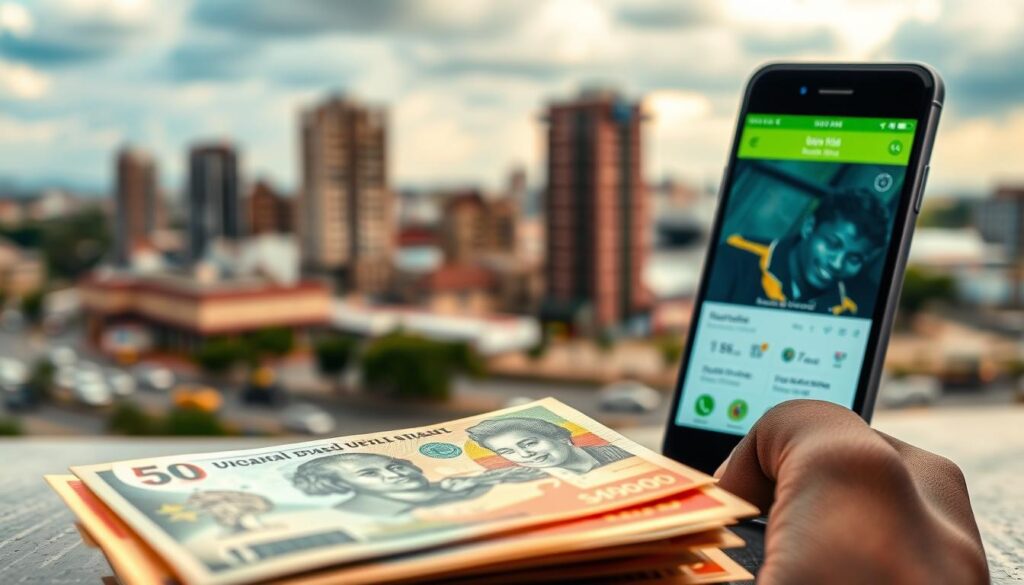Traveling to or doing business in Uganda? Knowing about the Ugandan Shilling is key. Introduced in 1966, the Ugandan Shilling, or UGX, is central to Uganda’s economy.
Did you know the Ugandan Shilling comes in different sizes? It’s used for most things in the country. Knowing about Uganda’s currency will make your trip better, whether you’re shopping or working.
Key Takeaways
- The Ugandan Shilling is the official currency of Uganda.
- It was introduced in 1966 and is abbreviated as UGX.
- Understanding the Ugandan Shilling is essential for travelers and businesses.
- The currency is available in various denominations.
- The Ugandan Shilling plays a crucial role in Uganda’s economy.
The Ugandan Shilling: An Overview
The Ugandan Shilling is Uganda’s official currency. It’s key to the country’s economy. Let’s explore why.
Official Currency of Uganda
The Ugandan Shilling is at the heart of Uganda’s economy. It’s used by everyone, from individuals to businesses. The Central Bank of Uganda controls it, keeping it stable and trustworthy.
The Central Bank of Uganda works hard to keep the currency strong. They manage inflation and make sure there’s enough money in circulation. This is vital for keeping people’s trust in the currency.
Currency Symbol and Code
The Ugandan Shilling is known by the code UGX and symbol Sh. Knowing these symbols is important for financial dealings, especially when dealing with international money. You’ll see them in financial reports and online currency platforms.
When you’re in Uganda, knowing the UGX code and Sh symbol is crucial. It helps you with financial services and makes transactions easier.
In summary, the Ugandan Shilling is essential to Uganda’s economy. The Central Bank of Uganda regulates it. Understanding the currency’s symbol, code, and the bank’s role helps you with financial transactions in Uganda.
Historical Development of the Currency of Uganda
Learning about Uganda’s currency history helps us understand its economic path. The country’s currency evolution shows its shift from old systems to new financial systems.
Pre-Colonial Currency Systems
Before colonial times, Uganda used different ways to trade. Goods like salt, cattle, and cloth were key in these trades. This shows how clever early Ugandan societies were.
“The use of cattle as currency was widespread in many African societies, including Uganda, due to their value and the ease of standardization.”
Colonial Era Currency
The colonial era changed Uganda’s money system a lot. The East African Shilling was introduced, becoming a common currency in East Africa, including Uganda. This was a big step towards a more unified money system.
| Era | Currency Used | Notable Features |
|---|---|---|
| Pre-Colonial | Bartering, cattle, cloth | Commodity-based, localized |
| Colonial | East African Shilling | Standardized, regional |
| Post-Independence | Ugandan Shilling | National sovereignty, modernized |
Post-Independence Currency Evolution
After gaining freedom, Uganda started using its own money, the Ugandan Shilling, in 1966. This move was key for Uganda’s financial freedom. The Ugandan Shilling has changed a lot since then, with updates and new money types.
The story of Uganda’s currency shows the country’s strong economy and ability to adapt. As Uganda grows economically, its money plays a big role in its financial system.
Denominations and Features of Ugandan Shilling
Knowing the Ugandan Shilling’s denominations is key for handling money in Uganda. The Shilling comes in banknotes and coins for various transactions.
Banknotes in Circulation
The Ugandan Shilling banknotes range from 1,000 to 50,000 shillings. They are designed to be unique and secure. Each note features important Ugandan figures and landmarks.
Banknote Denominations:
- 1,000 Shillings
- 2,000 Shillings
- 5,000 Shillings
- 10,000 Shillings
- 20,000 Shillings
- 50,000 Shillings
These banknotes have advanced security features to fight counterfeiting. Each has a unique design for easy identification.
Coins and Their Specifications
The Ugandan Shilling also comes in coin form. Coins are for everyday use and come in smaller denominations. They are minted with different specifications to tell them apart.
| Denomination | Material | Shape |
|---|---|---|
| 100 Shillings | Brass | Round |
| 200 Shillings | Copper-Nickel | Round |
| 500 Shillings | Nickel-Brass | Round |
| 1,000 Shillings | Bimetallic | Round |
Coins are made to last, perfect for daily use.
The Central Bank of Uganda’s Role in Currency Management
The Central Bank of Uganda is key in managing Uganda’s currency. It ensures the currency is stable and trustworthy. The bank handles everything from issuing new money to fighting counterfeits.
Regulatory Functions
The Central Bank of Uganda regulates Uganda’s financial system, including its currency. It makes policies for issuing and managing money. Good regulation builds trust in the financial system.
The bank works with banks and other financial groups to follow these rules. It checks the quality of money in use, looking for wear and spotting fakes. This effort keeps the Ugandan Shilling strong.
Currency Issuance and Control
The Central Bank of Uganda is the only one that can issue currency. It designs, prints, and distributes banknotes and coins. The bank makes sure there’s enough money for the economy and takes old money out of circulation.
“The Central Bank’s role in currency issuance is critical to maintaining economic stability.”
To manage money well, the Central Bank uses several strategies. It controls foreign exchange and the money supply. These steps help keep the currency stable and prevent inflation.
Anti-Counterfeiting Measures
Counterfeiting is a big problem for any currency, and Uganda is no exception. The Central Bank uses advanced security in its money to stop fakes. This includes watermarks, holograms, and other tech that makes it hard to make fake money.
The bank also works with police to catch and punish counterfeiters. It runs public campaigns to teach people how to spot real money. This helps keep the Ugandan Shilling safe and trusted.
Through these efforts, the Central Bank of Uganda protects the Ugandan Shilling. This keeps trust in the currency and the financial system strong.
Current Exchange Rates and Value Fluctuations
Knowing the current exchange rates of the Ugandan Shilling is key for anyone handling foreign money. Whether you’re traveling, running a business, or investing, keeping up with the Uganda currency rate is vital. It helps you make smarter financial choices.
The exchange rate of the Ugandan Shilling against big currencies like the USD and EUR changes due to many economic factors. These changes can affect your money dealings. So, it’s important to watch the rates closely.
Ugandan Shilling Against Major Currencies
The value of the Ugandan Shilling against major currencies is shaped by economic signs, trade balances, and money policies. Here’s a quick look at the current exchange rates:
| Currency | Exchange Rate (UGX) | Change |
|---|---|---|
| USD | 3,800 | +1.2% |
| EUR | 4,200 | -0.5% |
Factors Affecting Exchange Rate in Uganda
Many things affect the exchange rate in Uganda. These include inflation rates, economic growth, political stability, and global commodity prices. Knowing these can help you guess future changes in the currency rate.
For example, more coffee exports, a big money earner for Uganda, can make the Shilling stronger against the USD. But, political instability can make the currency weaker.
As you deal with forex Uganda, it’s crucial to keep up with the latest economic news and trends. This info lets you make wise choices about your foreign currency dealings.
How to Exchange Money in Uganda
Traveling to Uganda means you need to know how to exchange your money. Uganda has many ways to exchange currency, making it easy for visitors to handle their money.

Banks and Official Exchange Bureaus
You can exchange money at banks and official exchange bureaus in Uganda. Banks are a safe choice, offering good exchange rates. Big banks like Stanbic Bank, Standard Chartered, and Barclays Bank are available. Official exchange bureaus are also common, especially in tourist spots and big cities like Kampala.
It’s smart to compare rates at banks and bureaus to find the best deal. Some bureaus might give better rates for certain currencies, so it’s worth looking around.
ATMs and Credit Card Usage
ATMs are handy for getting cash in Uganda, especially in cities. Many ATMs take international cards, letting you get Ugandan shillings. But, some ATMs charge a fee, so check with your bank about foreign transaction fees.
Credit card usage is getting more common, with many places accepting major cards. Still, it’s wise to have local currency for small buys or in remote places.
Tips for Getting the Best Rates
Here are some tips for the best exchange rates in Uganda:
- Compare exchange rates at different banks and bureaus.
- Avoid exchanging money at airports or hotels, as rates tend to be less favorable.
- Use ATMs to withdraw local currency to get a better rate.
- Be cautious of unofficial exchange dealers, as they may offer poor rates or be involved in scams.
By being informed and careful, you can manage your money well during your Uganda visit.
Banking System and Forex Services in Uganda
Uganda has a well-developed banking system that supports its economy. You can find many financial services through different banks and institutions.
Major Banks in Uganda
Uganda’s banking sector is led by several major banks. They offer a wide range of financial services. Some of the key players include:
- Stanbic Bank Uganda
- Standard Chartered Uganda
- Centenary Bank
- Barclays Bank Uganda
- Equity Bank Uganda
These banks provide services like personal banking, corporate banking, and investments. You can pick from various account types, credit options, and investment products. They are designed to meet your specific needs.
Forex in Uganda: Services and Regulations
Forex services are key in Uganda’s banking system. They help with international trade and travel. Authorized dealers, including banks and forex bureaus, offer these services. The Bank of Uganda oversees these transactions to ensure they follow international standards.
It’s important to know the rules and choose authorized dealers for forex. Also, be aware of current exchange rates and any fees for transactions.
International Money Transfers
Banks and specialized services help with international money transfers. You can send and receive money worldwide through Western Union and MoneyGram. They work with local banks and agents.
Banks in Uganda also handle international money transfers. This lets you send money abroad or receive it from overseas. These services follow rules and may have fees and exchange rate changes.
To make international transactions smooth, you need the right documents. This includes valid ID and the recipient’s details.
Digital Currency and Mobile Money in Uganda
In Uganda, digital currency and mobile money are changing the financial scene. They make it easier and more convenient for people to handle money.
Mobile Money Platforms
Mobile money services are big in Uganda. They let users do financial tasks with their phones. MTN Mobile Money and Airtel Money are top choices, offering things like sending money and paying bills.
“The adoption of mobile money has been a game-changer for financial inclusion in Uganda,” a report says. It’s because it lets people manage money easily, without needing banks.

Cryptocurrency Adoption and Regulation
Cryptocurrency is getting more popular in Uganda. More people and businesses are looking into it. But, the rules around it are still being figured out.
- Cryptocurrency exchanges are popping up, where you can buy and sell digital currencies.
- The Bank of Uganda is making rules for using cryptocurrency.
Future of Digital Currency in Uganda
The future of digital currency in Uganda looks bright. Mobile money and cryptocurrency use are expected to grow. As rules get clearer, digital currency will likely become more important in Uganda’s finance world.
“As digital currency becomes more integrated into the financial system, it will be crucial for regulatory bodies to balance innovation with consumer protection.”
The journey of digital currency and mobile money in Uganda will keep moving forward. It will be driven by new tech and how people use money.
Economic Context of the Currency of Uganda
Exploring Uganda’s currency means looking at its economy. The economy’s state affects the currency’s value and stability.
Uganda’s Economic Overview
Uganda’s economy has a mix of farming, industry, and services. It has seen steady growth, mainly thanks to farming.
Agricultural Sector: Farming is key to Uganda’s economy. It employs many and boosts exports.
Inflation and Monetary Policy
Inflation is key to Uganda’s currency value. The Bank of Uganda works to keep inflation low and the economy stable.
“The Bank of Uganda uses various tools, including interest rates and reserve requirements, to manage inflation and ensure the stability of the financial system.”
Monetary policy decisions affect the economy and currency value. Changing interest rates can influence spending and investment.
Trade and Foreign Investment Impact
Trade and foreign investment shape Uganda’s currency. A trade surplus can make the currency stronger, while a deficit can weaken it.
| Economic Indicator | Impact on Currency | Current Trend |
|---|---|---|
| Trade Balance | A surplus strengthens the currency | Moderate surplus |
| Foreign Investment | Increased investment strengthens the currency | Increasing |
| Inflation Rate | High inflation weakens the currency | Moderate |
Knowing these economic indicators helps understand the currency’s performance. As the economy changes, so will the currency’s value.
Conclusion: Navigating Uganda’s Monetary Landscape
Understanding Uganda’s money system is key. You now know about the Ugandan shilling, its history, and what affects its value.
Exploring Uganda’s economy helps you make smart choices about money. This knowledge is useful for business, investing, or traveling.
To navigate Uganda’s money scene, keep up with exchange rates. Knowing what influences them helps you manage your money better in Uganda.
FAQ
What is the official currency of Uganda?
The official currency of Uganda is the Ugandan Shilling. It was introduced in 1966.
What is the symbol and code for the Ugandan Shilling?
The Ugandan Shilling is known by its code, UGX. Its symbol helps with financial transactions.
How is the Ugandan Shilling managed?
The Central Bank of Uganda manages the Ugandan Shilling. They ensure its stability and integrity.
What are the available denominations of the Ugandan Shilling?
The Ugandan Shilling comes in different denominations. Banknotes are for higher amounts, and coins for smaller ones.
How can I exchange money in Uganda?
You can exchange money in Uganda at banks, official bureaus, and ATMs. ATMs are great for those with international cards.
What factors affect the exchange rate of the Ugandan Shilling?
The exchange rate of the Ugandan Shilling is influenced by several factors. These include economic indicators and trade balances.
What is the role of the Central Bank of Uganda in currency management?
The Central Bank of Uganda is crucial for the Ugandan Shilling. They manage its stability and fight counterfeiting.
Are digital currencies and mobile money widely used in Uganda?
Yes, digital currency and mobile money are big in Uganda. They make transactions easy and are growing in use.
How does the economic context of Uganda impact its currency?
Uganda’s economy affects its currency. Factors like inflation and trade balances play a big role.
What are the best practices for exchanging currency in Uganda?
For the best exchange rates, know your options and watch for fees. Use official places like banks and licensed bureaus.
Can I use international debit or credit cards in Uganda?
Yes, you can use international cards at ATMs in Uganda. It’s easy to get your money.
What is the future of digital currency in Uganda?
Uganda’s digital currency future looks bright. There are efforts to regulate it, and more people are using it.

Adam G
This post was created by Adam G, a seasoned financial writer with a passion for explaining currency exchange and market movements
